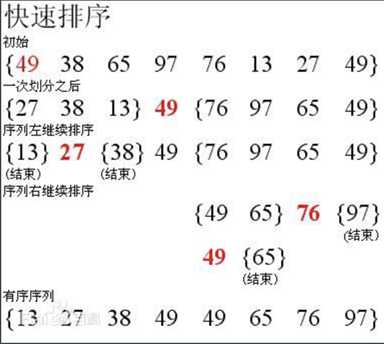标签:dex ble 简单选择 bubble isp 长度 有序 最大的 快速排序
一. 冒泡排序算法
1.第一次排序时将序列[0 ~ n - 1]中从前往后进行两个相邻元素的比较,若前者较大则交换,比较n-1次;
当第一趟排序结束时,序列最大的元素就被交换到位置n-1上,就如同一个气泡,一步一步往后翻滚,直到最后一位。
2.重复步骤1,在第i趟时需要翻滚n-i-1次,每趟决定一个元素的位置,一共需要n-1趟。
比如,初始序列: [1, 5, 4, 3, 2]
第1趟: [1, 4, 3, 2 ] 5
第2趟: [1, 3, 2 ] 4, 5
......
- (void)bubbleSort:(NSMutableArray *)array { int i, y; BOOL bFinish = YES; for (i = 1; i<= [array count] && bFinish; i++) { bFinish = NO; for (y = (int)[array count]-1; y>=i; y--) { if ([[array objectAtIndex:y] intValue] < [[array objectAtIndex:y-1] intValue]) { [array exchangeObjectAtIndex:y-1 withObjectAtIndex:y]; bFinish = YES; } } } }
二、简单选择排序算法
简单选择排序的基本思想:
1.第一趟在初始序列[0 ~ n-1]中找最小值元素,并与位置为0的元素交换位置。
2.第i趟在序列[i-1, n-1]中进行,找到最小值元素与位置为i-1的元素交换位置。每次决定一个元素的位置,经过n-1趟后使得初始序列有序。
比如,初始序列:[1, 5, 4, 3, 2]
第1趟:1 [5, 4, 3, 2]
第2趟:1 2 [4, 3, 5]
......
- (void)selectSort:(NSMutableArray *)array { int i, j; for (i=0; i<array.count-1; i++) { int index = i; for (j = i+1; j<array.count; j++) { if ([array[j] intValue] < [array[index] intValue]) { index = j; } } [array exchangeObjectAtIndex:i withObjectAtIndex:index]; } }
三、快速排序算法 (reference : 百度百科)

/** 快速排序方法 @param array 源数组 @param startIndex 开始Index @param endIndex 结束Index */ -(void)quickSortDataArray:(NSMutableArray *)array withStartIndex:(NSInteger)startIndex andEndIndex:(NSInteger)endIndex{ //只是一个基本的判断,如果数组长度为0或1时返回。 if (startIndex >= endIndex) { return ; } NSInteger i = startIndex; NSInteger j = endIndex; //记录比较基准数 NSInteger key = [array[i] integerValue]; while (i < j) { /**** 首先从右边j开始查找比基准数小的值 ***/ while (i < j && [array[j] integerValue] >= key) {//如果比基准数大,继续查找 j--; } //如果比基准数小,则将查找到的小值调换到i的位置 array[i] = array[j]; /**** 当在右边查找到一个比基准数小的值时,就从i开始往后找比基准数大的值 ***/ while (i < j && [array[i] integerValue] <= key) {//如果比基准数小,继续查找 i++; } //如果比基准数大,则将查找到的大值调换到j的位置 array[j] = array[i]; } //将基准数放到正确位置 array[i] = @(key); /**** 递归排序 ***/ //排序基准数左边的 [self quickSortDataArray:array withStartIndex:startIndex andEndIndex:i - 1]; //排序基准数右边的 [self quickSortDataArray:array withStartIndex:i + 1 andEndIndex:endIndex]; }
标签:dex ble 简单选择 bubble isp 长度 有序 最大的 快速排序
原文地址:http://www.cnblogs.com/ouyangfang/p/6670107.html